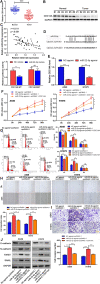Long noncoding RNA LINC00968 inhibits proliferation, migration and invasion of lung adenocarcinoma through targeting miR-22-5p/CDC14A axis
- PMID: 34603911
- PMCID: PMC8440738
- DOI: 10.1007/s13205-021-02981-8
Long noncoding RNA LINC00968 inhibits proliferation, migration and invasion of lung adenocarcinoma through targeting miR-22-5p/CDC14A axis
Retraction in
-
Retraction Note: Long noncoding RNA LINC00968 inhibits proliferation, migration and invasion of lung adenocarcinoma through targeting miR-22-5p/CDC14A axis.3 Biotech. 2023 May;13(5):120. doi: 10.1007/s13205-023-03531-0. Epub 2023 Apr 5. 3 Biotech. 2023. PMID: 37033386 Free PMC article.
Abstract
Lung adenocarcinoma (LUAD) is a high aggressive human cancer which usually diagnosed at advanced stages. Accumulating evidences indicate that long noncoding RNAs (lncRNAs) are crucial participants in LUAD progression. In the present study, we found that lncRNA LINC00968 was significantly down-regulated in LUAD tissues and cell lines. LINC00968 level was positively correlated to survival rate, and negatively correlated to tumor node metastasis (TNM) stage, tumor size and lymph node metastasis of LUAD patients. We over-expressed LINC00968 in LUAD cells using lentivirus, inhibited proliferation and cell cycle arrest at G1 phase were detected. LINC00968 over-expression also suppressed migration, invasion and epithelial mesenchymal transition. We further validated that LINC00968 localized in cytoplasm and acted as an upstream regulator of microRNA miR-22-5p, which was up-regulated in LUAD tissues and cell lines. Besides, elevated miR-22-5p expression abolished the effect of LINC00968 over-expression on LUAD progression including in vivo tumor growth. In addition, we first validated that cell division cycle 14A (CDC14A), which was down-regulated in LUAD tissues, was a downstream target of miR-22-5p. We over-expressed CDC14A in LUAD cells and miR-22-5p induced LUAD progression was partially reversed. In conclusion, our study demonstrated that LINC00968 inhibited proliferation, migration and invasion of LUAD by sponging miR-22-5p and further restoring CDC14A. This novel regulatory axis might provide us with promising diagnostic and therapeutic target in LUAD treatment.
Keywords: CDC14A; LINC00968; Lung adenocarcinoma progression; miR-22-5p.
© King Abdulaziz City for Science and Technology 2021.
Conflict of interest statement
Conflict of interestThe authors declare that no competing interests exist.
Figures





Similar articles
-
linc00968 inhibits the tumorigenesis and metastasis of lung adenocarcinoma via serving as a ceRNA against miR-9-5p and increasing CPEB3.Aging (Albany NY). 2020 Nov 5;12(22):22582-22598. doi: 10.18632/aging.103833. Epub 2020 Nov 5. Aging (Albany NY). 2020. PMID: 33159015 Free PMC article.
-
LINC00968 can inhibit the progression of lung adenocarcinoma through the miR-21-5p/SMAD7 signal axis.Aging (Albany NY). 2020 Nov 4;12(21):21904-21922. doi: 10.18632/aging.104011. Epub 2020 Nov 4. Aging (Albany NY). 2020. PMID: 33147570 Free PMC article.
-
LncRNA SGMS1-AS1 regulates lung adenocarcinoma cell proliferation, migration, invasion, and EMT progression via miR-106a-5p/MYLI9 axis.Thorac Cancer. 2021 Jul;12(14):2104-2112. doi: 10.1111/1759-7714.14043. Epub 2021 Jun 1. Thorac Cancer. 2021. PMID: 34061466 Free PMC article.
-
LncRNA TTN-AS1 promotes migration, invasion, and epithelial mesenchymal transition of lung adenocarcinoma via sponging miR-142-5p to regulate CDK5.Cell Death Dis. 2019 Jul 30;10(8):573. doi: 10.1038/s41419-019-1811-y. Cell Death Dis. 2019. PMID: 31363080 Free PMC article.
-
LncRNA LINC00511 promotes COL1A1-mediated proliferation and metastasis by sponging miR-126-5p/miR-218-5p in lung adenocarcinoma.BMC Pulm Med. 2022 Jul 16;22(1):272. doi: 10.1186/s12890-022-02070-3. BMC Pulm Med. 2022. PMID: 35842617 Free PMC article.
Cited by
-
Characterization and validation of a ferroptosis-related LncRNA signature as a novel prognostic model for lung adenocarcinoma in tumor microenvironment.Front Immunol. 2022 Aug 9;13:903758. doi: 10.3389/fimmu.2022.903758. eCollection 2022. Front Immunol. 2022. PMID: 36016939 Free PMC article.
-
Hsa-miR-22-3p inhibits liver cancer cell EMT and cell migration/ invasion by indirectly regulating SPRY2.PLoS One. 2023 Feb 7;18(2):e0281536. doi: 10.1371/journal.pone.0281536. eCollection 2023. PLoS One. 2023. PMID: 36749775 Free PMC article.
-
FABP7 inhibits proliferation and invasion abilities of cutaneous squamous cell carcinoma cells via the Notch signaling pathway.Oncol Lett. 2022 Jun 10;24(2):254. doi: 10.3892/ol.2022.13374. eCollection 2022 Aug. Oncol Lett. 2022. PMID: 35765272 Free PMC article.
-
Novel tumor necrosis factor-related long non-coding RNAs signature for risk stratification and prognosis in glioblastoma.Front Neurol. 2023 Apr 20;14:1054686. doi: 10.3389/fneur.2023.1054686. eCollection 2023. Front Neurol. 2023. PMID: 37153654 Free PMC article.
-
m6A transferase KIAA1429 mediates the upregulation of LncRNA LINC00968 promoting the progression of gastric cancer cells.Hereditas. 2025 Mar 11;162(1):34. doi: 10.1186/s41065-025-00393-9. Hereditas. 2025. PMID: 40069867 Free PMC article.
References
-
- Birney E, Stamatoyannopoulos JA, Dutta A, Guigo R, Gingeras TR, Margulies EH, Weng Z, Snyder M, Dermitzakis ET, Thurman RE. Identification and analysis of functional elements in 1% of the human genome by the ENCODE pilot project. Nature. 2007;447:799–816. doi: 10.1038/nature05874. - DOI - PMC - PubMed
-
- Fagerberg L, Hallstrom BM, Oksvold P, Kampf C, Djureinovic D, Odeberg J, Habuka M, Tahmasebpoor S, Danielsson A, Edlund K. Analysis of the human tissue-specific expression by genome-wide integration of transcriptomics and antibody-based proteomics. Mol Cell Proteomics. 2014;13:397–406. doi: 10.1074/mcp.M113.035600. - DOI - PMC - PubMed
Publication types
LinkOut - more resources
Full Text Sources

